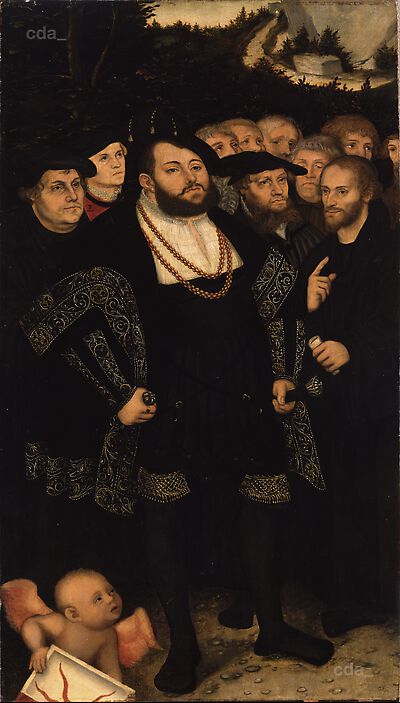In 1517 Martin Luther (1483-1546) famously nailed to the door of the Castle Church in Wittenberg his Ninety-five Theses arguing against the corrupt practices of Catholic Church, sparking the Protestant Reformation. Toledo's rare painting, executed some twenty-five years later, shows Luther with his fellow Reformers and the Elector of Saxony,
In 1517 Martin Luther (1483-1546) famously nailed to the door of the Castle Church in Wittenberg his Ninety-five Theses arguing against the corrupt practices of Catholic Church, sparking the Protestant Reformation. Toledo's rare painting, executed some twenty-five years later, shows Luther with his fellow Reformers and the Elector of Saxony, John Frederick the Magnanimous (ruled 1532-1547). The splendidly dressed John Frederick, who protected the Wittenberg reformers from the Catholic Church and the Holy Roman Emperor, is the dominant figure. Behind him, at the left, is Luther; at the far right, holding a scroll and pointing upward, is Luther's chief associate, humanist scholar Philipp Melanchthon (1497-1560). The man behind Luther is most often identified as Georg Spalatin (1484-1545), while the man behind John Frederick's left shoulder is probably Saxon Chancellor Gregor Brück (1485-1557). The other figures have not been satisfactorily identified.
The painting is a fragment of a larger composition, possibly the wing of a triptych. The reformers are apparently witnesses to some event to their left and above, at which many gaze. The partial, unidentified coat of arms held by the winged putto was probably that of the patron of the painting. Numbers painted on some of the figures seem to have been added early in the painting's existence and once corresponded to a list of names on the back of the panel.
Lucas Cranach the Younger worked in the studio of his father, Saxon court artist Lucas Cranach the Elder, taking over the workshop upon his father's death in 1553. Cranach the Elder painted many portraits of Martin Luther, and remained his lifelong friend. Besides the family relationship to Luther, Cranach the Younger was intimately connected to other Reformers in the painting: in 1541 he married the daughter of Gregor Brück. After being widowed in 1550, he married the niece of Phillip Melanchthon.
[http://classes.toledomuseum.org:8080/emuseum/view/objects/asitem/People$00402838/0?t:state:flow=fe148e42-73da-4659-aa47-7977bd227504] (accessed 22.03.2013)
